

RNA driving the epigenetic bus : Article : The EMBO Journal. Dynamic changes to chromatin structure appear to constitute the senior level of gene regulation during differentiation and development by determining which loci may be open or closed for expression, although it has been assumed that this is itself controlled by transcription factors.
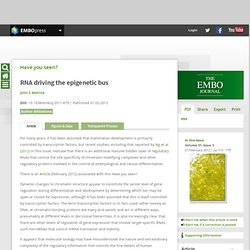
The term ‘transcription factors’ is, in fact, used rather loosely as DNA‐ or chromatin‐binding proteins are many and varied, and act in different ways, presumably at different levels in decisional hierarchies. It is also increasingly clear that there are other levels of regulation of gene expression that involve target‐specific RNAs, such microRNAs that control mRNA translation and stability. These studies have now been extended by Ng et al (2012), who analysed a set of lncRNAs that are dynamically regulated during the differentiation of human stem cells into neurons and, using siRNA knockdown, identified subsets that are involved either in the maintenance of pluripotency or in neuronal differentiation.
Evidence of altered RNA stirs debate. RNAi. RNA editing study under intense scrutiny. Three groups1–3 today throw fuel on the debate surrounding a researcher’s claim to have discovered a twist in the mechanism whereby genes are translated into proteins.
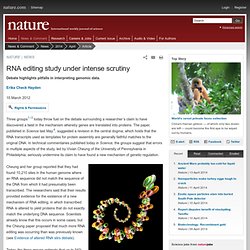
The paper, published in Science last May4, suggested a revision in the central dogma, which holds that the RNA transcripts used as templates for protein assembly are generally faithful matches to the original DNA. In technical commentaries published today in Science, the groups suggest that errors in multiple aspects of the study, led by Vivian Cheung of the University of Pennsylvania in Philadelphia, seriously undermine its claim to have found a new mechanism of genetic regulation. The idea that RNA is often edited after being transcribed from DNA is a controversial one.
Cheung and her group reported that they had found 10,210 sites in the human genome where an RNA sequence did not match the sequence of the DNA from which it had presumably been transcribed. New year, new science. Leukemia - MicroRNAs in acute leukemia: from biological players to clinical contributors. Insight: Regulatory RNA. Modular regulatory principles of large non-coding RNAs : Nature. It is clear that RNA has a diverse set of functions and is more than just a messenger between gene and protein.
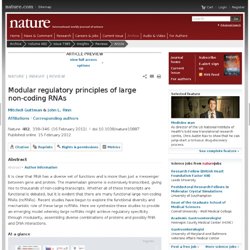
The mammalian genome is extensively transcribed, giving rise to thousands of non-coding transcripts. An alternative mode of microRNA target recognition : Nature Structural & Molecular Biology. MicroRNAs (miRNAs) regulate mRNA targets through perfect pairing with their seed region (positions 2–7).

Recently, a precise genome-wide map of miRNA interaction sites in mouse brain was generated by high-throughput sequencing and analysis of clusters of ~50-nucleotide mRNA tags cross-linked to Argonaute (Ago HITS-CLIP). By analyzing Ago HITS-CLIP 'orphan clusters'—Ago binding regions from HITS-CLIP that cannot be explained by canonical seed matches—we have now identified an alternative binding mode used by miRNAs. Specifically, G-bulge sites (positions 5–6) are often bound and regulated by miR-124 in brain. More generally, bulged sites comprise ≥15% of all Ago-miRNA interactions in mouse brain and are evolutionarily conserved. We call position 6 the 'pivot' nucleotide and suggest a model in which a transitional 'nucleation bulge' leads to functional bulge mRNA-miRNA interactions, expanding the number of potential miRNA regulatory sites.
View full text. Animation and slideshow : RNAi. Article body Our knowledge of RNA interference — popularly known as RNAi — has expanded dramatically in the short time since its discovery.

Several types of small silencing RNAs have now been discovered, including small interfering RNAs (siRNAs), microRNAs (miRNAs) and PIWI-interacting RNAs (piRNAs). Should we stay or should we go: mechanisms and ecological consequences for biofilm dispersal : Abstract : Nature Reviews Microbiology. Inhibition of miR-33a/b in non-human primates raises plasma HDL and lowers VLDL triglycerides : Nature. 1deGoma, E.

M. & Rader, D. J. Novel HDL-directed pharmacotherapeutic strategies. Nature Rev. Cardiol. 8, 266–277 (2011)CAS Article Google Scholar 2Moore, K. Biogenesis of 2-agmatinylcytidine catalyzed by the dual protein and RNA kinase TiaS : Nature Structural & Molecular Biology. Lunchtime science : Nature. Weak seed-pairing stability and high target-site abundance decrease the proficiency of lsy-6 and other microRNAs : Nature Structural & Molecular Biology. A Non-coding RNA of Insect HzNV-1 Virus Establishes Latent Viral Infection through MicroRNA : Scientific Reports. Access : Synergistic Silencing: Combinations of Lipid-like Materials for Efficacious siRNA Delivery : Molecular Therapy. Commercial Teas Highlight Plant DNA Barcode Identification Successes and Obstacles : Scientific Reports. Specimen collection CS and herbal tea products from New York City stores, school dining halls, and homes of investigators were collected during October 2009-February 2010. 146 products were obtained from 25 locations, representing 33 manufacturers, 17 countries, and 82 plant common names.
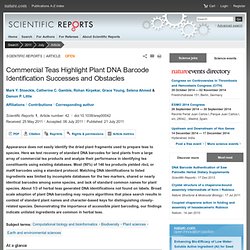
As this study was designed to enable comparison between CS and herbal teas and not among individual products or manufacturers, products were assigned an arbitrary alphanumeric code. 73 were C. sinensis, and 73 were herbal products prepared from other plant species. Five herbal products contained C. sinensis together with other plants. 44 herbal teas (60.3%) listed a single ingredient; the remainder named 2–10 different plants. When not specified on the label, scientific and common name equivalents were determined from the reference used by the U.S. Food and Drug Administration35. Reference samples C. sinensis var. assamica specimens (n = 17) were collected in Yunnan, China by SA during 2007–2009. Molecular Systems Biology. Results and discussion We initially based our analysis on murine Th2 cells (Zhu et al, 2010), as these cells can be obtained in large quantities ex vivo and can be prepared as a pure and homogeneous cell population.

Furthermore, there is a well‐characterized set of genes whose proteins are known to be expressed and functional in Th2 cells, as well as a set of genes known to be not expressed in these cells (Supplementary Table S1 lists the genes we used in our study, Supplementary Figure S1 shows expression of two marker proteins in the cells). We generated Th2 poly(A)+ RNA‐seq data for two biological replicates and calculated gene expression levels using the standard measure of Reads Per Kilobase per Million (RPKM; Mortazavi et al, 2008, Supplementary Table S2 gives the number of reads and mappings we obtained). The expression levels of the biological replicates are highly correlated (r2=0.94, Supplementary Figure S2).
Figure 1. Distribution of gene expression levels. Figure 2. Figure 3. Mapping in vivo protein-RNA interactions at single-nucleotide resolution from HITS-CLIP data : Nature Biotechnology. Analysis of HITS-CLIP data to identify CIMS After RBP-RNA complexes are purified in the standard CLIP procedure (Fig. 1a), the bound RBPs are removed by proteinase digestion.
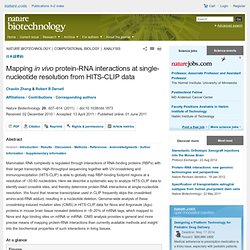
However, because UV crosslinking is irreversible, the residual amino-acid-RNA adducts impose a potential obstacle for reverse transcriptase to read through when RNA fragments are converted into cDNAs. At a certain frequency, reverse transcriptase stops at the crosslink site, resulting in a truncated cDNA. However, reverse transcriptase can also read through these sites17, resulting in either a correct read or an error at the crosslink site, because of crosslink-induced interference with normal Watson-Crick base-pairing. Open access comes of age. A universal code for RNA recognition by PUF proteins : Nature Chemical Biology. RNA–protein complexes have essential roles in the regulation of gene expression and are also vital for cell differentiation and the complex developmental programs of multicellular eukaryotes1, 2.
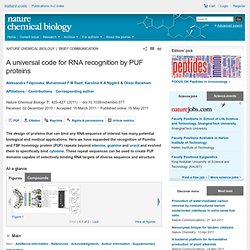
Proteins bind RNAs in diverse modes that are often difficult to predict3, limiting the ability to engineer RNA-binding proteins for biotechnological and medical applications4. The potential of such tools is analogous to the use of short interfering RNAs and microRNAs; however, the use of short RNA duplexes to target RNAs is limited to lowering their abundance or expression in the cytoplasm, and this depends on RNA interference pathways5. SWI/SNF nucleosome remodellers and cancer : Abstract : Nature Reviews Cancer. Evidence of altered RNA stirs debate. Mapping in vivo protein-RNA interactions at single-nucleotide resolution from HITS-CLIP data : Nature Biotechnology. Metabolic labeling of RNA uncovers principles of RNA production and degradation dynamics in mammalian cells : Nature Biotechnology.
Cellular RNA levels are determined by the interplay of RNA production, processing and degradation. However, because most studies of RNA regulation do not distinguish the separate contributions of these processes, little is known about how they are temporally integrated.